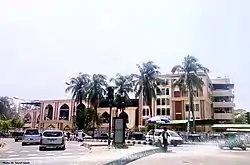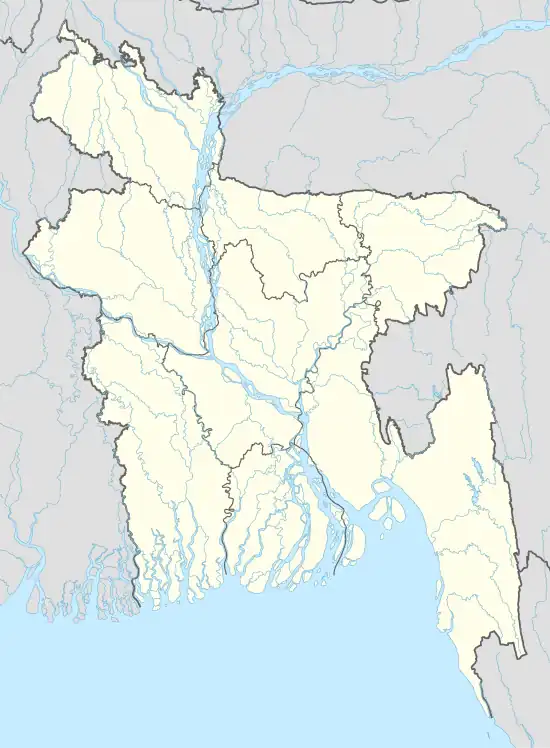Kakrail Mosque
Malwali Masjid/Mosque, Kakrail Markaz (Bengali: মালওয়ালী মসজিদ, কাকরাইল মারকাজ) is a mosque in the Kakrail neighbourhood of Ramna Dhaka, Bangladesh.[1][2] Located near Ramna Park, it is the centre of the Tabligh Jamat in Bangladesh.
| Malwali Masjid/Mosque, Kakrail Markaz | |
|---|---|
মালওয়ালী মসজিদ, কাকরাইল মারকাজ | |
 Tabligh Jamat Bangladesh.
তাবলীগ জামাত বাংলাদেশ। | |
| Religion | |
| Affiliation | Islam The Followers of Ummah |
| District | Dhaka ঢাকা |
| Leadership | Now Kakrail Markaz is being managed by two disputed groups of tablighi jamat. Followers of Aalami Suras (World Sura) controls the markaz for 28 days and followers of Nizamuddin Maulana Sad Kandhlawi Tablighi jamat controls the markaz for 14 days. |
| Location | |
| Location | Kakrail, Ramna, Dhaka, Bangladesh. কাকরাইল, রমনা, ঢাকা, বাংলাদেশ। |
| Municipality | Dhaka Metropolitan City Corporation |
 Shown within Bangladesh  Kakrail Mosque (Dhaka) | |
| Geographic coordinates | 23.7369°N 90.4035°E |
| Architecture | |
| Architect(s) | Haji Abdul Mukit Saheb RH. |
| Founder | 2nd Hazratji Maulana Mohammad Yousuf Shaheb Kandhlawi (RH.) 2nd Aamir of World Tablighi Jamat |
activists
The mosque is being managed by two disputed groups of tablighi jaamat. Followers of Aalami Suras controls the markaz for 28 days and followers of Nizamuddin (Tablighi Jamaat) Sad Followers controls the markaz for 14 days
History
There is disagreement as to when and by whom the mosque was first built but it is seemingly the case that a previous mosque existed in the premises prior to Tablighi administration. Some claim that the original mosque was made of tin and built by the gardeners (known as Malis) of nearby Ramna Park. It was known as Malwali Masjid (Bengali: মালওয়ালি মসজিদ).[3] It is known from the senior attendants that a mosque was established here by a member of the Nawab family of Dhaka about 300 years ago, along with other installations by the family. In the beginning, the mosque was quite small and had a small pond in front.
In 1952, the Tablighi Jamaat movement in Bangladesh relocated their headquarters from Khan Mohammad Mridha Mosque, and declared the Kakrail Mosque as its Markaz (centre). [4] The three-storey mosque was rebuilt under the supervision of Haji Abdul Muqit, an architect belonging to the Tablighi Jamaat.[5]
Architecture
The present mosque is designed by engineer Haji Abdul Muqit. Adjacent to the roof of the mosque are triangular carvings. The pillars of the mosque are square in shape. The west wall of the mosque is rippling. The mosque also has wide verandas on three sides. On the south and north sides there are two pond-like houses for Wudu rituals and can serve hundreds of people at once. There are also more modern arrangements for performing Wudu outside of the mosque building. A short distance north of the mosque is a two-storey building for toilets and bathrooms.[5] There are no entrance doors and so it is open day and night.[7]
See also
References
- Siddiqi, Mohammad. The Tablighi Jamaat in Bangladesh and the UK: an ethnographic study of an Islamic reform movement. OCLC 891697830.
- Siddiqi, Bulbul (29 November 2017), "Bishwa Ijtema as a New Form of Islamic Pilgrimage", Becoming 'Good Muslim', Springer Singapore, pp. 77–100, doi:10.1007/978-981-10-7236-9_6, ISBN 9789811072352
- Hasan Mohammad (2012). "Tabligh". In Sirajul Islam; Miah, Sajahan; Khanam, Mahfuza; Ahmed, Sabbir (eds.). Banglapedia: the National Encyclopedia of Bangladesh (Online ed.). Dhaka, Bangladesh: Banglapedia Trust, Asiatic Society of Bangladesh. ISBN 984-32-0576-6. OCLC 52727562. OL 30677644M. Retrieved 27 October 2023.
- Ghazi Abdul Hadi (21 January 2010). তাবলিগ জামাতের কাকরাইল মসজিদ কিছুটা ব্যতিক্রম. Kaler Kantho (in Bengali).
- কাকরাইল মসজিদের ইতিহাস ও দাওয়াতি কার্যক্রম. Desh Shomoy (in Bengali).
- "First phase of Bishwa Ijtema ends with final prayer for peace". bdnews24.com. 12 January 2020. Retrieved 24 June 2023.
- "Kakrail Mosque & Tablig Markaz". TouristPlaces.com.bd.
_002.jpg.webp)